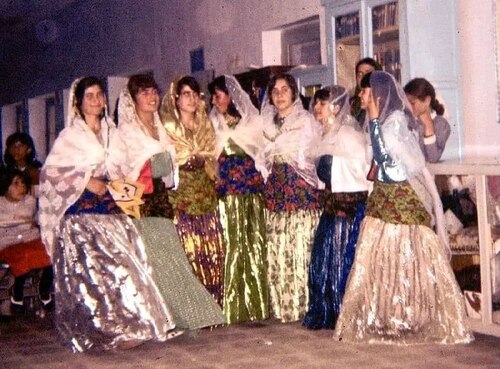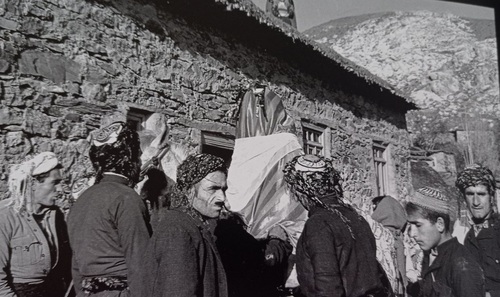Eating Sweets
A ceremony in which relatives of the groom's family go to the bride's house on the wedding day or another specific day and give her a set of clothes (dress, Pishtwen, Dasmal, Pishtakawa) and several pieces of gold as gifts. On this day, the bride and groom exchange rings and eat sweets or honey together. There will be a feast and dancing.
There were no eating sweets in the old days, and the bride and groom often did not see each other.

Buying Clothes
In the old days, the groom's family considered it a shame to go to the bride's house and left the affairs to a woman called Barbuk (Bride's maid). They sent a bag of clothes to the bride's house to choose her favorite clothes. They bought two or three clothes for her. So, on the day of sweets, they would put some sweets on clothes and the clothes on a tray and show them to the women. Barbuk would go to the groom's house and stay with the bride for a week to prove her virginity and return to tell the groom's family.
The groom's family gave her a set of clothes, money, sugar, flour, and cheese and sent her away.

Khanabandan
In the old days, on the night before the wedding, girls, relatives, friends, and acquaintances would gather, and each would take a bag of Khana (henna) and go to the bride's house. They mostly would cook meat (a kind of soup with means meat made into Kifta) and invite everyone. They prepared Khana and put it in their hands and feet.
Nowadays, the groom's family goes to the bride's house and prepares Khana, and each girl put a little on their palm.

Making Bride Ready
Several women and relatives gather before the wedding, one of whom removes facial hair for the bride and one of whom dyes her hair (by Khana). Before sewing, the bride's dress is given to a woman who is happily married to cut the piece with scissors for the bride's good luck and happiness.
On the wedding day, a fortunate woman is brought to the room where the bride is made up and she is in a wedding dress wearing Shada and Gelgela (Kurdish hat for women) and red Tara (veil) and put money in her shoes to be happy feet for money.

Wedding night
On the day the groom's family comes to take the bride, the bride and groom's family invite people and go to the bride after lunch. In the old days, if the way was far, they would go to the bride in the morning because they did not have a car and they would the bride off on horseback. The groom was not allowed to go to the bride's house. Sometimes, instead of the groom's brother, they brought two boys of the groom's relatives or friends as best men. They went to the bride with nobles and the groom's relatives (women did not go). On the two sides of the bride, her brother or uncles took her hands to get on the horse. They would send Barbuk with her too.

To tie the bride's Pishtwen
A thin red piece about a meter and a half long was given to a best man, who would move it three times from the bride's head to the bride's feet and tie it around her waist a third time, and the bride's family would give him a gift. Before the bride left her father's house, they would put eggs under her feet for good luck.

The Bride Gets off
In the old days, if the bride was on a long way, she would ride a horse. Sometimes, she would get tired and get off the horse, and the groom's family would sacrifice a cow for her. They would throw sweets on her head. When the bride got off, the bride's mother would off the veil and put gold on her clothes, and later, the relatives put on gold on her. They placed mirrors in front of the bride and groom and honey, halva, or sweets to love each other. They would put a little boy in the bride's arms, wishing to give birth to a boy and support the tribe, and she would give them money.
They brought two-colored tea to the bride and groom, who stirred it, and the groom paid for the tea. Later, they would take the bride and groom to the feast and throw money at them.

Serozhana (The third day)
On the day after the wedding, the bride's relatives would dress up and go to the groom's house. They would have lunch and the bride would wear the same clothes as on the day of the wedding, but she would not wear a veil. The party and dancing would be held for a day and finally, everyone would go back to their homes.









